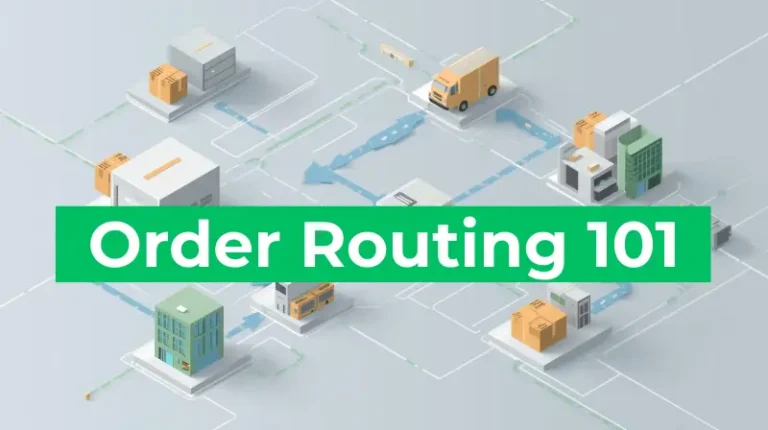What is DHL eCommerce and Why It’s Important for Online Sellers

Last updated on July 23, 2025
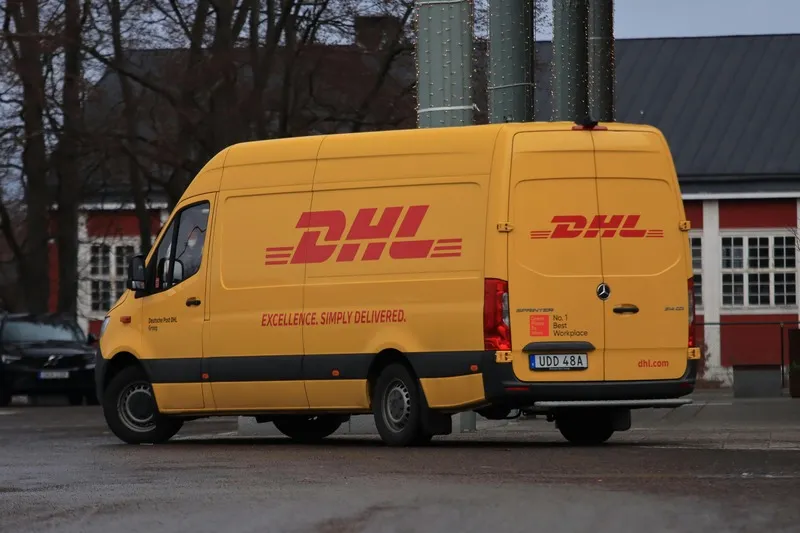
In this article
 12 minutes
12 minutes
- Key Takeaways
- DHL eCommerce: An Overview
- Affordable Shipping Solutions
- Domestic Shipping Services
- International Shipping Options
- Hybrid Delivery Model
- Integration with Ecommerce Platforms
- Real-Time Tracking and Transparency
- Operational Pitfalls
- What They Don’t Tell You: Hidden Costs in DHL’s Latest Rate Hike
- Customs and Trade Considerations
- Sustainability Initiatives
- Checklist for Sellers
- Summary
- Frequently Asked Questions
DHL eCommerce provides shipping solutions for online businesses worldwide. Learn about its services, benefits, and how it can improve your shipping process.
Key Takeaways
- DHL eCommerce offers affordable and scalable shipping solutions, making it suitable for businesses of all sizes, with no minimum volume requirements.
- The company provides fast domestic shipping options, with services like Expedited Max averaging delivery in just 2 – 3 days.
- Commitment to sustainability is a key focus for DHL eCommerce, as they aim for net-zero emissions by 2050 through their GoGreen program.
DHL eCommerce: An Overview
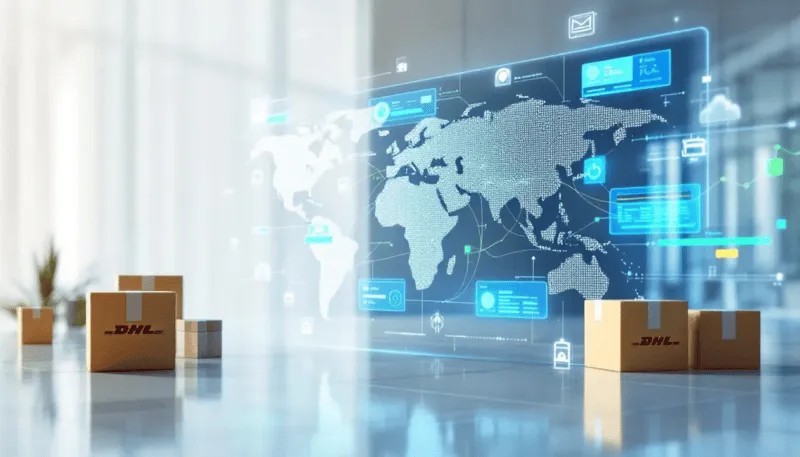
DHL eCommerce is a division of Deutsche Post DHL Group, specializing in domestic and international shipping solutions for ecommerce merchants around the world. With operations in over 220 countries and territories, DHL eCommerce shipments provide extensive global reach, making it a reliable partner for businesses looking to expand their market presence.
The company employs over 45,000 specialists focused on ecommerce logistics, ensuring that your shipments are handled by experienced professionals. DHL eCommerce offers services for ecommerce businesses, marketplaces, and B2B shippers, helping them manage their logistics effectively as a logistics company. This makes it an ideal choice for businesses of all sizes, from small startups to large enterprises.
Sustainability is also a key focus for DHL eCommerce, aligning with green logistics goals to promote environmentally friendly practices. Partnering with DHL eCommerce allows businesses to grow and meet changing demands while contributing to a more sustainable future.
Slash Your Fulfillment Costs by Up to 30%
Cut shipping expenses by 30% and boost profit with Cahoot's AI-optimized fulfillment services and modern tech —no overheads and no humans required!
I'm Interested in Saving Time and MoneyAffordable Shipping Solutions
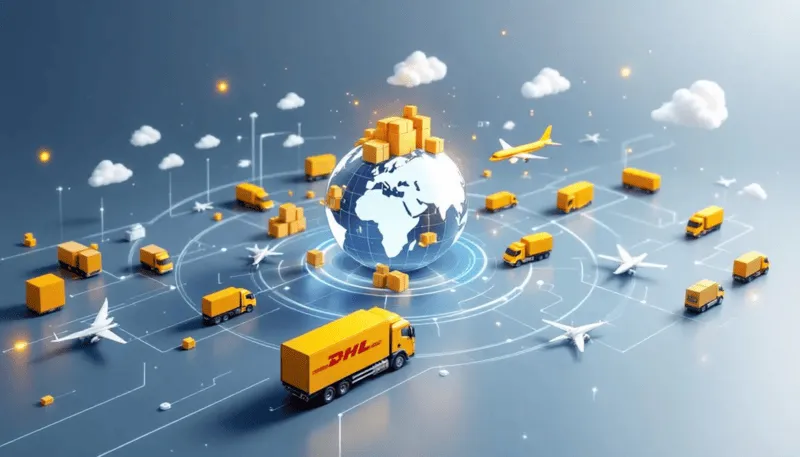
One of the standout features of DHL eCommerce is its affordability, particularly for international parcels. While rates vary based on size, weight, and service level, many ecommerce sellers report that DHL eCommerce often provides lower-cost options compared to USPS for similar cross-border shipments. For example, shipping a lightweight package from the U.S. to the UK can be significantly cheaper through DHL’s Parcel International Direct service compared to USPS Priority Mail International. This price advantage makes DHL eCommerce a compelling choice for businesses seeking cost-effective international delivery without compromising global reach.
DHL eCommerce offers:
- Scalable pricing models that adjust based on order volume, allowing businesses to save on costs as more shipments are processed.
- No minimum volume requirements, making DHL accessible for businesses of varying sizes. But note that ultra-low tier pricing is only available to high-volume shippers (e.g., 1,500+ packages per month).
- A transparent pricing structure that factors in both weight and dimensions, ensuring that you know exactly what you’re paying for.
DHL eCommerce offers competitive pricing for lightweight packages by consolidating and pre-sorting shipments, reducing costs and simplifying the shipping process. With its global network and partnerships with various carriers, DHL eCommerce makes it easy for businesses to expand their reach and deliver packages efficiently.
For example, a Brooklyn-based apparel brand shipping lightweight t-shirts to customers in California saved nearly 35% on each DHL eCommerce shipment compared to USPS Ground Advantage. By using DHL’s scalable pricing and consolidating shipments during peak sale periods, they optimized both cost and delivery accuracy, while avoiding common USPS delays.
Domestic Shipping Services
DHL eCommerce offers a range of domestic shipping services to cater to different needs. One of the popular specific services is the Expedited Max service, which ensures faster deliveries with an average postal time of just 2 – 3 days. The Ground shipping service averages 3 – 8 days for delivery, suitable for less time-sensitive shipments.
Another notable service is the SmartMail Parcel, designed for packages weighing up to 25 lbs. This service allows for a maximum shipment value protection of up to $100, providing peace of mind for valuable items.
DHL eCommerce delivery times can range from 2 to 8 business days for domestic shipments within the United States, making it a versatile option for various shipping needs. These options allow businesses to tailor their shipping strategies to meet customer expectations and ensure timely deliveries, whether expedited or more cost-effective ground shipping is needed.
A popular DTC skincare brand uses Expedited Max for its starter kits under 1 lb—ensuring delivery in 2 – 3 days—while heavier bottles are shipped via Ground to keep shipping costs down. This dual strategy lets them meet shopper expectations on speed while preserving margin.
International Shipping Options
DHL ecommerce services comparison table.

DHL eCommerce provides robust international shipping solutions for businesses aiming to expand globally. The DHL Parcel International Direct service offers:
- Coverage of 37 important ecommerce markets
- Shipping times range from 3 to 10 business days
- Options for duty paid in advance or upon delivery, simplifying the customs process for businesses
The Parcel International Standard service delivers to over 220 countries and territories, with transit times of 4 to 8 business days for Europe and Canada, and 8 to 14 days for the rest of the world. This service is ideal for businesses looking to reach a wider audience without breaking the bank.
For smaller parcels under 4.4 lbs, DHL Packet International offers a cost-effective solution with expected delivery times of 4 to 8 business days. These options enable businesses to select the most suitable service based on shipping needs and destination country, ensuring timely and efficient deliveries worldwide.
However, brands shipping to the UK or Canada should closely monitor customs documentation. One merchant selling tech accessories saw delays of up to 7 days due to missing HS codes on shipping labels, a preventable issue that impacted their ability to confirm delivery dates and caused complaints from international shoppers.
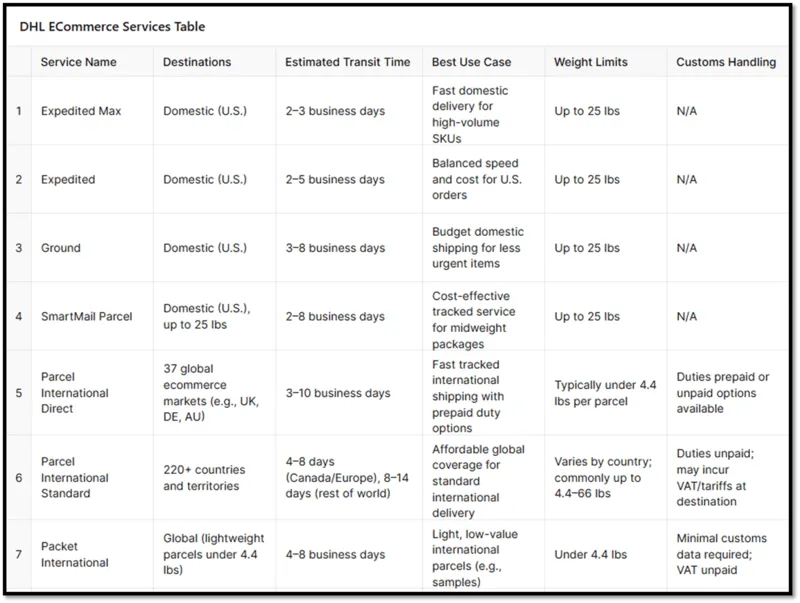
Looking for a New 3PL? Start with this Free RFP Template
Cut weeks off your selection process. Avoid pitfalls. Get the only 3PL RFP checklist built for ecommerce brands, absolutely free.
Get My Free 3PL RFPHybrid Delivery Model
DHL eCommerce employs a hybrid delivery model that combines the strengths of DHL and USPS. In this model, DHL manages upstream logistics, including sorting and processing packages at distribution centers, then transfers them to USPS for last-mile delivery.
This collaboration allows DHL eCommerce to offer economical shipping solutions while ensuring reliable last-mile service through USPS. However, reliance on USPS can lead to service variability across regions, which businesses should keep in mind when planning their shipping strategies.
For example, a Texas-based seller noticed consistent delays in rural New England ZIP codes when DHL hands off to USPS. To mitigate this, they adjusted cut-off times and proactively updated customers with tracking links to manage expectations, a tactic that helped reduce customer service tickets by 18%.
Integration with Ecommerce Platforms
DHL eCommerce seamlessly integrates with all major ecommerce platforms, making it easier for businesses to manage their shipping operations. Key features include:
- Marketplace sellers can connect their accounts for a streamlined shipping experience.
- Simplified parcel delivery and returns.
- Real-time rate retrieval for shipments, improving efficiency and accuracy in pricing.
The 1-call buys feature simplifies the shipping label purchase process, accelerating operations and helping businesses grow. By connecting with platforms like Shopify, Pulse Commerce, and BigCommerce, DHL eCommerce ensures that businesses can manage their orders and shipments with ease.
Real-Time Tracking and Transparency
Transparency is key in the shipping process, and DHL eCommerce excels in providing real-time tracking for shipments. Key features include:
- The Delivery Confirmation Service offers tracking from the sender to the recipient.
- Ensures visibility throughout the shipping journey, providing important details.
- Particularly beneficial for international shipments, where comprehensive tracking is crucial.
DHL eCommerce utilizes advanced technologies and features to enhance shipment tracking.
- Uses GPS and RFID to provide accurate real-time updates on the location of shipments.
- Minimizes human error and enhances automation in tracking parcels.
- Sends proactive notifications to customers regarding any delays or issues during the shipping process, improving their overall experience.
With various tracking solutions, such as API and On-Demand Delivery options, DHL eCommerce caters to diverse business needs, ensuring that both merchants and consumers have access to reliable tracking information.
Operational Pitfalls
While DHL eCommerce offers numerous benefits, there are also operational challenges to be aware of. Many sellers experience tracking delays, particularly during peak shipping seasons, which can lead to customer dissatisfaction. Inadequate communication with logistics partners and the shipper can exacerbate these issues, leading to unforeseen delays in order fulfillment.
Disruptions in supply chains can significantly impact shipping timelines for DHL eCommerce users. Additionally, certain SKUs, particularly those containing hazardous materials, cannot be shipped through DHL eCommerce, making compliance essential. Establishing clear guidelines for unacceptable shipment types is crucial for avoiding pitfalls and ensuring smooth operations.
A seller in the supplements category learned this the hard way when a batch of shipments containing hemp-based products was flagged during transit. Despite full compliance on the origin country side, destination country regulations caused parcel returns and spam-level customer support volume. Lesson learned: Review restricted items by both carrier and country before you ship.
DHL eCommerce’s tracking updates depend on timely USPS tracking event updates, making it important for sellers to monitor these closely. By being proactive and aware of these potential challenges, businesses can gain valuable insights to better navigate the complexities of using DHL eCommerce for their shipping needs.
What They Don’t Tell You: Hidden Costs in DHL’s Latest Rate Hike
If you blinked, you might’ve missed it, but DHL quietly implemented another round of rate increases in July 2025. While smaller than the dramatic spike that took effect in January, these new rates still chip away at the cost advantage many merchants once counted on.
Let’s break it down.
In early 2024, DHL was one of the most affordable shipping options for lightweight parcels, especially in Zones 1 and 2. Fast forward to July 2025, and that edge is eroding. Rates for 1 – 5 oz parcels in Zones 1 & 2 have climbed significantly—often by $0.10 to $0.20 per package. That might sound negligible, but if you’re shipping 10,000 orders per month, that’s a $1,000–$2,000 hit to your bottom line.
What most merchants miss:
- Price creep is consistent across all weight breaks. The increases are small but relentless.
- The biggest relative jumps are at the lightest weights (1 – 3 oz), a core volume segment for ecommerce.
- Zone compression no longer delivers the savings it used to. Previously, you could count on Zones 1 & 2 to be reliably cheap. Now, even “local” deliveries are being repriced to match broader zone costs.
This isn’t just a DHL issue. It’s the downstream effect of new USPS pricing agreements that have reshaped how DHL and other consolidators structure their pricing tiers. In short: the margins are tighter, and their flexibility is fading.
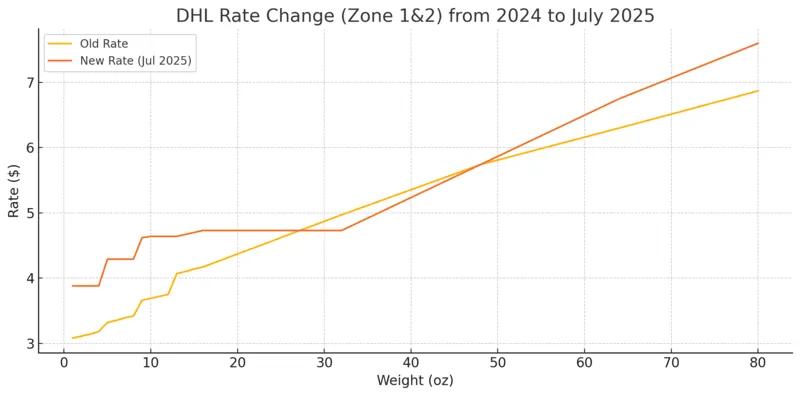
Customs and Trade Considerations
International shipping involves navigating complex customs and trade regulations. DHL eCommerce provides options for customs clearance, letting businesses choose between prepaid or unpaid duties, thus streamlining international shipping processes and avoiding unexpected costs.
Changes in U.S. tariffs do not apply to shipments that have already left their origin, and no current exemptions exist for small businesses regarding tariffs. This situation has created challenges for many businesses who are advised to explore existing trade agreements to obtain tariff impacts and stay informed about changing trade regulations to help their business grow.
Sustainability Initiatives
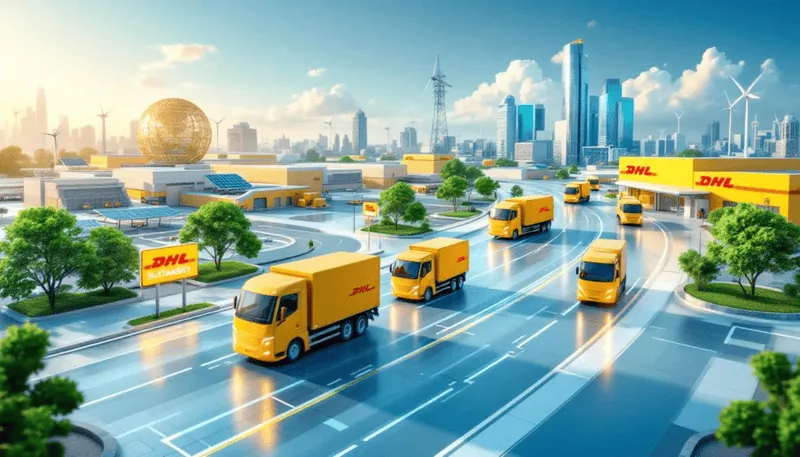
DHL eCommerce is committed to sustainability, as demonstrated by its GoGreen program. The company aims for net-zero emissions by 2050, encouraging employees to engage in climate protection initiatives. This collective effort emphasizes the importance of individual contributions to combat climate change.
The GoGreen program fosters a culture of environmentally friendly behavior within DHL and encourages customers to adopt sustainable practices. Choosing DHL eCommerce allows businesses to align with eco-friendly shipping solutions and contribute to a more sustainable future.
Scale Faster with the World’s First Peer-to-Peer Fulfillment Network
Tap into a nationwide network of high-performance partner warehouses — expand capacity, cut shipping costs, and reach customers 1–2 days faster.
Explore Fulfillment NetworkChecklist for Sellers
DHL can be a powerful ally, but only if you treat it as one part of your fulfillment toolkit. Hybrid delivery, tracking intelligence, and adaptive networks (like Cahoot) are how you thrive in 2025’s logistics landscape.
- Checklist: Before you go all-in on DHL…
- Know your SKU best fit (size/weight limits)
- Be GDPR & customs-ready for cross-border parcels
- Build tracking automation for 48-hour gaps in tracking updates
- Add a fulfillment backup plan for shipments >$800 (de minimis changes may lead to customs delays or rejections)
- Build sustainability/consumer transparency into shipping costs
By following this checklist, sellers can optimize their use of DHL eCommerce and ensure smooth operations.
Summary
In summary, DHL eCommerce offers a comprehensive suite of shipping solutions designed to meet the needs of ecommerce businesses. From affordable domestic and international shipping options to real-time tracking and sustainability initiatives, DHL eCommerce provides the tools necessary for businesses to thrive in the competitive online market.
Many merchants adopt a hybrid strategy, using DHL eCommerce for non-urgent items and maintaining parallel channels with a faster delivery service provider like DHL Express or UPS for high-ticket or time-sensitive orders. This hybrid approach keeps costs in check while meeting the diverse delivery expectations of today’s online shoppers.
By leveraging these services, businesses can enhance their shipping processes, improve customer satisfaction, and contribute to a more sustainable future. Whether you’re a small startup or a large enterprise, DHL eCommerce has the solutions to help you succeed.
Frequently Asked Questions
What is the delivery time for DHL eCommerce domestic shipping services in the United States?
DHL eCommerce domestic shipments typically take 2 to 8 business days, depending on the specific shipping service selected. Options like Expedited Max average 2 – 3 days, while Ground shipping may take up to 8 days. Delivery timelines are influenced by package weight, destination location, and USPS’s last-mile performance.
How long does DHL eCommerce international shipping take for online shoppers sending packages abroad?
DHL eCommerce offers several international shipping services. For example, Parcel International Direct delivers to 37 countries in about 3 to 10 business days, while Parcel International Standard ships to over 220 countries in 4 to 14 days. Shipping times vary based on the destination country, service type, and customs clearance.
What is DHL eCommerce’s hybrid delivery model and how does it affect shipping performance?
The hybrid delivery model used by DHL eCommerce combines DHL’s global logistics infrastructure with USPS for domestic last-mile delivery. This allows ecommerce businesses to access affordable, reliable shipping while benefiting from USPS’s nationwide reach. However, tracking and delivery times may vary depending on USPS efficiency in the final delivery zone.
Does DHL eCommerce offer real-time tracking for shipments and delivery confirmation?
Yes, DHL eCommerce provides real-time shipment tracking through GPS and RFID technologies. Merchants and customers can track packages across every stage of the shipping process, from pickup to final delivery. The Delivery Confirmation service ensures visibility and enhances trust, especially for international ecommerce shipments.
What sustainability programs does DHL eCommerce offer for eco-conscious ecommerce businesses?
DHL eCommerce is committed to sustainable logistics through its GoGreen program, which aims for net-zero carbon emissions by 2050. The company invests in alternative fuels, electric vehicles, and climate protection initiatives, helping ecommerce merchants align their shipping operations with environmentally responsible practices.

Turn Returns Into New Revenue



